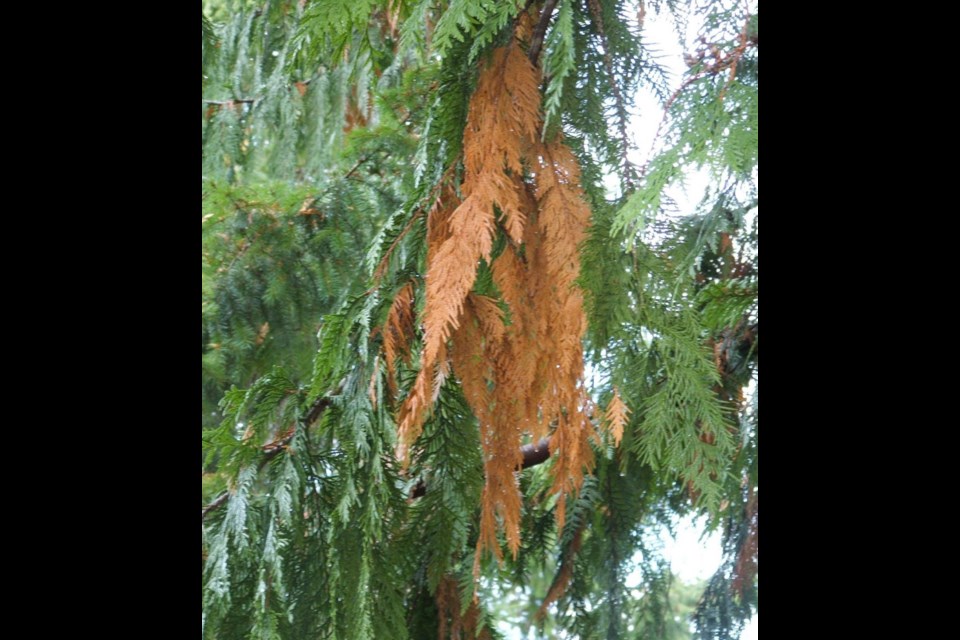Dear Helen: I recently saw a newspaper article about western red cedars dying off because of drought. The cedars in my neighbourhood developed some brown patches this fall. Does this mean they are dying?
S.N.
Probably not. Cedar “flagging” is a natural process of shedding patches of old foliage. Affected areas, which are evenly distributed throughout the tree, turn reddish brown in late summer and early autumn. Winter winds and rain blow and wash the dried parts from the tree. By spring, it looks fresh and green again. Flagging is a tree’s normal renewal process.
In certain areas of Vancouver Island something different is being observed in our native cedar trees. Whole tree tops die off and turn brown, followed by further and finally full die-back of the trees. Dying off, starting at the top of a tree, indicates a lack of sufficient soil moisture to transport water to the upper portion of a tree. Western red cedar trees growing in sites with shallow, dry, rocky soils are most susceptible to dieback.
Dear Helen: We moved into a home with a long, narrow back yard 39 years ago. Five years later a neighbour planted tall cedars against a section of our side fence that bordered a plot where we grew raspberries, which subsequently died. Replacement canes also died. Twenty years ago another neighbour planted a cedar hedge 45 cm from the other side fence. Despite a sheet metal barrier sunk into the ground, those cedars have sent roots into my garden. The reddish roots are a nasty tangle to dig, but I still get some vegetables. I also grow some plants in containers and have had success with a small “lasagna” garden. What can I do about this situation? Are vegetables grown in recently root-infested soil safe to eat? I’m too elderly to move.
I.M.
I garden in precisely the same conditions, next to skyscraper-high fir and cedar trees growing up against most parts of my side fencing. As the trees have grown over the four decades I’ve gardened here, and after a series of dry years, the roots have penetrated into almost all parts of my 27-metre wide property. A sheet metal soil barrier did nothing to help.
I’ve developed a routine of digging the fine tangle of reddish cedar roots out in small areas at a time. It’s hard work, and it’s wise at any age to vary tasks at each gardening session. If you can, enlist a little help with the root digging and other heavy work.
Over my years of cedar root digging I’ve often come across, deep-down, woody structures like reddish tree branches. These spread out from large cedar trees into adjoining areas and produce the fine, pungent roots that need digging out. You can see the start of these underground structures where a cedar tree flares out at the base.
There was once a large cedar tree growing next to my back fence. One day, I was talking with that neighbour over the fence when he happened to look down and notice how the base of his tree had sent growth into my vegetable garden and had obviously continued underground. He expressed surprise that his tree had so invaded my garden.
That evening, he phoned to say that he and his wife had decided to take the tree down because they were aware that I was trying to grow as much of my own food as possible. It was an extraordinary act of kindness. That back corner of the property is now the most trouble-free area in my food garden.
I grow food plants where cedar roots roam, with varying degrees of success. I’ve learned to choose the most root-free areas for the longer-term plantings like tomatoes and cucumbers and for greedy feeders like onions. Where the roots are most troublesome, I grow short-term plants like lettuce and spinach. The secret is ongoing root removal and soil replenishment.
Before planting, I dig out all the roots I can, lime the soil well (except for potato plantings), and add a generous layer, at least five cm thick, of nitrogen-rich home-made or purchased compost to dig in with fertilizer. As plantings develop, I mulch with more compost — around flowering time for tomatoes and peas — to keep the plants well nourished for a decent harvest. Regular soil care and replenishment can produce safe, nourishing food even in cedar-root territory.



